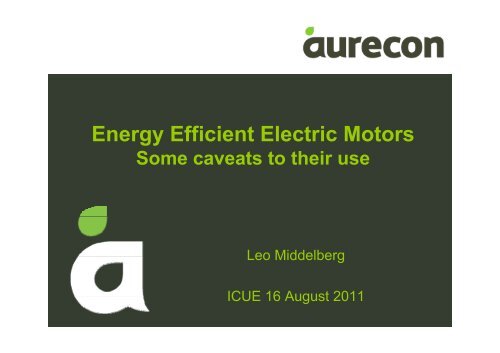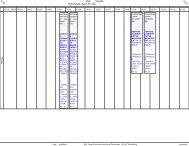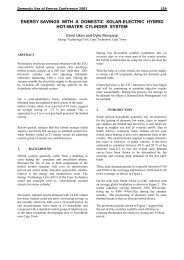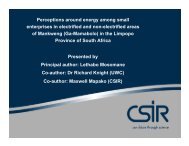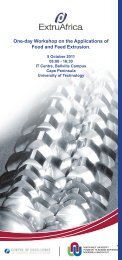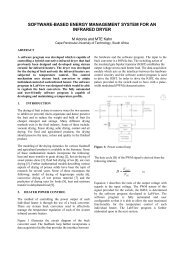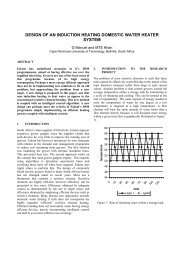Presentation - CPUT Active Web
Presentation - CPUT Active Web
Presentation - CPUT Active Web
You also want an ePaper? Increase the reach of your titles
YUMPU automatically turns print PDFs into web optimized ePapers that Google loves.
Energy Efficient Electric MotorsSome caveats to their useLeo MiddelbergICUE 16 August 2011
OVERVIEW• Introduction• Design of Efficient Motors• Drawbacks of Improvements in EEmotors• Practical Solutions to Overcome theseDrawbacks• Conclusion
INTRODUCTION• Approx. 56% of electrical energy in RSA is used byelectric motors (>80% in Industry)• SANS 600034 Part 30 introduces Energy Efficiency iclasses for Electric Motors• Currently the highest Efficiency class is IE3• IE3 motors have a 1% to 3% higher efficiency thanstandard motors (Can be higher for small motors)• However, there can be unintended consequences ifstandard motors are simply replaced by IE3 motors– even higher energy consumption!
OVERVIEW• Introduction• Design of Efficient Motors• Drawbacks of Improvements in EEmotors• Practical Solutions to Overcome theseDrawbacks• Conclusion
ENERGY LOSSES OCCURING IN ELECTRICMOTORS
OVERVIEW• Introduction• Design of Efficient Motors• Drawbacks of Improvements in EEmotors• Practical Solutions to Overcome theseDrawbacks• Conclusion
ENERGY LOSSES OCCURING IN ELECTRICMOTORS
Effect of the reduction in RotorResistance
ENERGY LOSSES OCCURING IN ELECTRICMOTORS
Not so obvious effect of reduction inMotor losses• Little can be done about the fluxleakage→ Power Factor Reduces• Lower Resistance→ Higher Inrush Currents
Torque – Speed RelationshipsTorque Speed Relationships32.52pu Torque1.51Square Torque Law LoadConstant Torque LoadInduction Motor 2Start Induction MotorInduction Motor 10.500 0.2 0.4 0.6 0.8 1 1.2pu Speed
Effects on Power
Effect of reduced Power Factor
Effect of reduced Power Factor ContinuedOutputIE2IE3PF*ηPF*ηPercentage Load50 75 100 50 75 1001,1 0.502 0.614 0.663 0.490 0.608 0.6781,5 0.465 0.598 0.664 0.487 0.619 0.6882,2 0.529 0.634 0.684 0.519 0.635 0.6964 0.550 0.659 0.711 0.550 0.659 0.7225,5 0.607 0.714 0.758 0.603 0.717 0.7717,5 0.630 0.721 0.765 0.628 0.732 0.7789,2 0.584 0.689 0.741 0.594 0.704 0.76211 0.579 0.686 0.749 0.592 0.698 0.76515 0.598 0.692 0.755 0.597 0.703 0.76318,5 0.622 0.716 0.760 0.590 0.706 0.76522 0.645 0.740 0.785 0.610 0.716 0.77730 0.630 0.725 0.770 0.594 0.702 0.77237 0.650 0.744 0.772 0.597 0.714 0.77545 0.690 0.778 0.805 0.659 0.758 0.80655 0.702 0.789 0.818 0.672 0.770 0.82075 0.694 0.784 0.812 0.710 0.790 0.83290 0.715 0.795 0.824 0.703 0.783 0.824110 0.707 0.789 0.827 0.706 0.795 0.835132 0.719 0.800 0.828 0.716 0.797 0.829
OVERVIEW• Introduction• Design of Efficient Motors• Drawbacks of Improvements in EEmotors• Practical Solutions to Overcomethese Drawbacks• Conclusion
Typical conventional Electric MotorDi Driven SystemEnergy towasteSupplyNetworkMotorDriven EquipmentGearboxEnergyConvertor50%EnergyControllerto Process95% 95%70% 50%50%System Eff = 0.95x0.95x0.7x0.5x0.5 = 16%Useable energyto process
Suggested Electric Motor Driven SystemSupplyNetworkDriven EquipmentEnergyControllerMotorGearboxEnergyto ProcessConvertor95% 95%95%70%50%System Eff = 0.95x0.95x0.95x0.7x0.5 = 30%Useable energyto process
Effect of Speed Control140.0Reduced Performance CRN64120.0100.0H (m)80.060.0100%(red)90%80.0%70%40.020.000.00.0 10.0 20.0 30.0 40.0 50.0 60.0 70.0 80.0 90.0Q(m^3/h)
PRACTICAL SOLUTIONS• Consider effect of increased speed• Reduced impellor diameter• Reduced stroke on positive displacement machines• Reduced loading on conveyor belts• Right Sizing of Electric Motors• Remember that efficiency and power factor reduce withreduced loading• Reduced Power Factor• Consider running Capacitors at Motor (e.g. in Local Start/StopStation)• Choosing Motors from a Catalogue
OVERVIEW• Introduction• Design of Efficient Motors• Drawbacks of Improvements in EEmotors• Practical Solutions to Overcome theseDrawbacks• Conclusion
CONCLUSIONS• Examine and calculate the SYSTEMefficiency, Use a Systems Approach• Consider PF correction at load• Consider impacts of higher speed of themotor• Right size motors• Rather control power input than energy addat the process (e.g. use VSDs )• Use IE3 motors for new applications butconsider the effects on speed etc.
CONCLUSIONS (Continued)• Consider using SANS 60034-31 as a guide tousing energy efficient i motors• Don’t legislate the use of IE3 motors as theEuropeans have done!
Thank you!Leo.Middelberg@aurecongroup.comcom
TORQUE / SPEED CURVES OF DIFFERENTCLASSES OF MOTORS
Torque – Speed Relationships
Effect of Voltage Drop on Motor Torque
Effect of Voltage Drop on Motor Torque


